Research Article Open Access
Effects of Experimental Horizontal Mandibular Deviation on Stepping Test of Equilibrium Function
| Kensuke Karasawa, Tomotaka Takeda*, Kazunori Nakajima, Go Yamazaki, Takamitsu Ozawa, Toshiki Fujii and Keiichi Ishigami | |
| Department of Sports Dentistry, Tokyo Dental College, 1-2-2 Masago, Mihama-ku, Chiba 261-0011, Japan | |
| Corresponding Author : | Tomotaka Takeda Associate Professor Department of Sports Dentistry Tokyo Dental College, 1-2-2, Masago Mihama-ku, Chiba 261-8502, Japan Tel: +81432703605 Fax: +81432703609 E-mail: ttakeda@tdc.ac.jp |
| Received December 16, 2013; Accepted January 16, 2014; Published January 24, 2014 | |
| Citation: Karasawa K, Takeda T, Nakajima K, Yamazaki G, Ozawa T, et al. (2014) Effects of Experimental Horizontal Mandibular Deviation on Stepping Test of Equilibrium Function. J Nov Physiother 4:192. doi: 10.4172/2165-7025.1000192 | |
| Copyright: © 2014 Karasawa K, et al. This is an open-access article distributed under the terms of the Creative Commons Attribution License, which permits unrestricted use, distribution, and reproduction in any medium, provided the original author and source are credited. | |
Visit for more related articles at Journal of Novel Physiotherapies
Abstract
The balance adjustments play an important role in orthostatic and dynamic postural control, influencing the ability to perform daily living and sports activities in preventing injuries and improving performances. And a stomatognathic system thought to be involved in postural control. However, the relation between stomatognathic system and the equilibrium function has not been made sufficiently explicit. The purpose of this study was to investigate an effect of an experimentally altering mandibular position on equilibrium using a planar inclination of body and fluctuation in centerof- foot pressure in orthostatic postureanda stepping test. Twelve healthy males (32.45 ± 9.2 years of age) participated as subjects. Rotation angle, transfer angle and transfer distance during the stepping test, and planar inclinations of the body and path length in center-of-foot pressure were determined at before stepping test, using force plates and the VICON motion capture system. Deviation and rest splints were fabricated using soft-and-hard double-layer sheets pressure formed on maxillary and mandibular models: the former was positioned at the edge of the upper and lower canines where they came into contact on the non-habitual chewing side; the latter was positioned at the mandibular rest position. Significantly greater inclination of the cranial, shoulder and pelvic planes and path length in center-of-foot pressure were observed with the deviation splint. And significant increases were observed in rotation angle, transfer distance, and transfer angle with the deviation splint compared with the rest position or with the rest splint. Within the limitations of this study, these results suggest that even the alteration in mandibular position affects equilibrium function.
| Keywords |
| Mandibular deviation; Equilibrium; Splint; Stepping test; Posture |
| Introduction |
| The balance adjustments play an important role in orthostatic and dynamic postural control, influencing the ability to perform daily living [1-4], the sports performances [5-8], the prevention of injuries [9-12]. Recently, attentions have been paid to the effect of balance control on sports issues as well as daily activity. |
| About improvement of sports performances: Balance training can be a worthwhile adjunct to the usual training of athletes to enhance certain motor skills [5]. Balance training using unstable boards was an effective training method for improving balance and the vertical jump in basketball players [6]. Expertise in shooting has a more pronounced effect on decreased sway in static balance conditions [7]. One-week of high intensity karate training induced a significant improvement in static body balance in preadolescent karate athletes. Karate performance requires high-levels of both static and dynamic balance [8]. |
| About prevention of sports injuries: A balance training program will significantly reduce the risk of ankle sprains in high school soccer and basketball players [9]. Insufficient neurologic input or improperly processing that input at the spinal, brain stem, or cognitive centers can lead to an inadequate response by the motor system resulting in an injury [10]. Proprioceptive and neuromuscular interventions after ankle and knee joint injuries can be effective for the prevention of recurrent injuries and the improvement of joint functionality [11]. The effectiveness of proprioceptive/neuromuscular training in reducing the incidence of certain types of sports injuries among adolescent and young adult athletes during pivoting sports [12]. |
| Stomatognathic system thought to be involved in postural control [13-16]. The temporomandibular joint makes muscular and ligamentary connections to the cervical region, forming a functional complex cranio-cervico- mandibular system, and the extensive afferent and efferent innervations of stomatognathic system are reflected in the extensive representation of the orofacial district in the motor and sensory areas of the cerebral cortex [17]. |
| It has been reported that problems in the stomatognathic system such as malocclusions [18], temporomandibular disorders [19,20] have an effect on stability and the maintenance of posture. These reports can be thought to imply that loss of sufficient occlusion may be involved with the occurrence of falling through some kind of mechanism [21]. However, the relation between problems of occlusion and the equilibrium function has not been made sufficiently explicit and a more detailed consideration may be necessary. |
| An experimental mandibular deviation splint has been used as a method by which to investigate the effect that changes or abnormalities in occlusal condition have on equilibrium function, that indicate effects on orthostatic [16,22,23], dynamic postural [13], gait [15] and gaze [23] functions. Thus, it can be considered that it is possible for occlusion deviation to disturb the posture of the body or cranium, impede the vestibular system, and have an impact on equilibrium functions. |
| A stepping test [24,25] is one of the equilibrium function test. In this test, a subject was instructed to perform stepping in place naturally with his/her eyes close. After 30 seconds stepping, at a stop location, a transfer distance, a transfer angle, and a rotation angle were measured and analyzed for an evaluation of equilibrium function. |
| In this study, a deviation splint was used to achieve temporary and reversible experimental condition of the mandible to the non-habitual chewing side [13] and investigated the effect on equilibrium functions using force plates and a motion capture system. Planar inclinations of body and fluctuation (path length) in center-of-foot pressure (COP, during orthostatic posture before the stepping test) and rotation angle, transfer angle, and transfer distance (during the stepping test) were measured and analyzed. |
| Materials and Methods |
| Participants |
| Twelve healthy adult males (32.45 ± 9.2 years of age) were selected from the faculty and students of Tokyo Dental College. No recognized subjective or objective abnormalities in the intraoral, mandibular joint, or head and neck muscles etc. were recognized in any of the subjects, and none had a past or present history of illness relating otolaryngological or ophthalmological ailments. Participants were told to refrain from medications (e. g., stimulants and/or depressants, cold medicines) and substances (e. g., coffee etc. including caffeine) that could affect their nervous systems before and during the period of testing, and meal of two hours before the test. They were also instructed to avoid excessive drinking and lack of sleep night before the test. The study protocol was approved by the Ethics Committee of College (Tokyo Dental College Ethics Committee Approval Number 212). All experiments were conducted in accordance with the latest version of the Declaration of Helsinki. In addition, the significance and details of this research, such as the experiment objective and methodology and the time involved, was sufficiently explained orally and in writing to the subjects, and their consent was obtained. |
| Fabrication of splints |
| Pairs of 3-mm, styrene/butadiene–block–copolymerisate and ethylene– vinylacetate–copolymerisate double-layer sheets (Kombiplast®, Dreve Dentamid GmbH, UNNA, Germany) were pressure-formed on models of the maxillary and mandibular dentition using the Dreve Drufomat (Type SO, Dreve-Dentamid). After correcting the form, each pair of molded Kombiplasts was placed on an articulated model. The mandible was then deviated at the point where the edge of the upper and lower canines came into contact on the non-habitual chewing side. Next, the Kombiplasts were integrated into a splint (hereafter referred to as deviation splint) using an autopolymerizing resin [13] (UNIFAST II®, GC corporation, Tokyo, Japan). After confirming the position, the splint was trimmed and inserted into the mouth (Figure 1-a: upper). A rest splint was also used, fixing the Kombiplasts in the rest position (Figure 1-a: lower). |
| Measuring devices (Three-dimensional coordination and ground reaction force) |
| A total of 88 reflective markers, 85 points of the Helen Hays Marker set [26] and three points added for mandibular plane analysis: the submental and bilateral mandibular angle, 14-mm in diameter were affixed to various points on the subject’s body and stereoscopic measurements made at a sampling frequency of 200 Hz using 12 motion capture cameras ( MX40, VICON, Oxford, UK) (Figure 1-b: upper). Ground reaction force data while stepping were obtained at a sampling frequency of 200 Hz using 6 force plates (BP400600-1000PT, ADVANCED MECHANICAL TECHNOLOGY, INC., MA, USA) (Figure 1-b: lower). |
| Measurement method |
| Environmental conditions were standardized to the extent possible [27], the laboratory was put under condition whereby the inside of the room was quiet and of a uniform brightness, and there were no impacts from light or sound. The subjects stood upright with their eyes closed in a close foot position presentation with the soles of the feet in a prescribed location such that each foot rested on a separate force plate. The subjects were instructed to assume a comfortable posture with both arms loosely at their sides, and to stand with each foot on a separate force plate. At the time of measurement, the subjects were barefoot and wore clothing that was close fitting and did not restrict motion. |
| Before the stepping test, the subjects kept standing for 20 seconds with their eyes closed on the force plates until their balance became stable [27], and then the body’s planar inclination 3 seconds prior to commencing the stepping test and the crosswise and anteroposterior directional path lengths at COP were measured (Figure 1-c). |
| Next, the subjects were instructed to begin stepping in place at a normal tempo, raising each thigh to a position parallel with the ground and keeping their arms stretched out to the front with their palms facing down on hearing the start signal (Figure 1-d, Left), after which the location they finished on was taken as the stop location. The distance covered from the start location to the stop location was taken as transfer distance; the direction taken as the transfer angle; and the angle the body rotated as the rotation angle (Figure 1-d, Right). Tests were performed in random order with either type of splint or in the mandibular rest position with 2-min breaks between each test. |
| Analysis method |
| Inclination of each part of body and path length in COP (prior to commencement of Stepping Test): The change of the cranium, mandible, shoulders and pelvis planes were analyzed. The orientation of each set of markers prior to commencement of the stepping test was taken to represent a plane [28,29]. The cranial plane was taken to be that linking the occiput and the left and right tragus. The mandibular plane was taken to be that linking the crosswise mandibular angle portion and the submental space. The shoulder plane was taken to be that linking the left and right acromion and the 7th thoracic vertebra. The pelvic plane was taken to be that linking the left and right spina iliaca anterior and the sacrum. The inclination of the body in the crosswise and anteroposterior directions for each plane at rest, with rest splint installed, and with deviation splint installed was measured at 3-sec intervals. Path length in the COP values was also measured taking the crosswise and anteroposterior directions into consideration [30,31]. |
| Rotation angle (Stepping test): The perpendicular line from the sacrum to the straight line linking the left and right spina iliaca anterior at commencement of the stepping test was taken as 0°, and the angle rotated by the end point was taken as the rotation angle (Figure 1-d: left). |
| Transfer angle/Transfer distance (Stepping Test): The angle and distance migrated from the left and right heel contact points at commencement of the stepping test to the left and right heel contact points at the end was taken to be the transfer angle, and the distance to be the transfer distance (Figure 1-d: left). |
| Statistical analysis |
| The Friedman test was used to assess difference among the three conditions of rest splint, deviation splint, and in the mandibular rest position. The Wilcoxon matched pair test was used for the subsequent multiple comparisons. A P value of <0.05 was considered to indicate statistical significance in all the analyses. The software package SPSS 11.0J for Windows (SPSS Inc., JAPAN) was used for the statistical analysis. |
| Results |
| The results of the Friedman test revealed that an alteration in intraoral conditions significantly affected each item analyzed. |
| Inclination of each area of body (prior to commencement of Stepping Test) |
| Figure 2 shows the results for each area of the body with crosswise (upper) or anteroposterior (lower) inclination. Crosswise inclination yielded significantly larger values in all planes with use of the deviation splint than with at rest or with the rest splint; significantly smaller values were also observed in all planes with the rest splint than at rest (Wilcoxon matched pair). Anteroposterior inclination also yielded significantly larger values in all planes with the deviation splint than at rest or with the rest splint; significantly smaller values were also observed in the shoulder and pelvic planes with the rest splint than at rest. |
| Path length in center-of-foot pressure (prior to commencement of Stepping Test) |
| Path length in COP showed significantly larger crosswise (Figure 3: upper) and anteroposterior (Figure 3: lower) values with the deviation splint than at rest or with the rest splint. |
| Rotation angle (Stepping test) |
| Rotation showed a median angle of 12.47° at rest, 13.21° with the rest splint, and 17.75° with the deviation splint. Significantly larger values were observed with the deviation splint than with at rest or with the rest splint (Figure 4: upper). |
| Transfer angle/Transfer distance (Stepping Test) |
| Transfer showed a median angle of 7.26° at rest, 5.88° with the rest splint, and 9.30° with the deviation splint. Significantly larger values were observed with the deviation splint than at rest or with the rest splint (Figure 4: middle). Transfer showed a median distance of 41.47 cm at rest, 39.03 cm with the rest splint, and 47.95 cm with the deviation splint. Significantly larger values were observed with the deviation splint than at rest or with the rest splint (Figure 4: lower). |
| Discussion |
| In this study, variation of the mandibular plane by means of a deviation splint yielded a significantly greater change in the cranial, shoulder and pelvic planes than at rest or with the rest splint. A similar result was observed for crosswise or anteroposterior path lengths in COP, which can be thought of as indicating a disturbance of posture. These results are parallel to the outcomes in related papers investigated orthostatic [22,23,32], dynamic postural [13], gait [15] and gaze [23] functions. For examples; Different jaws relations influence body posture, so called myocentric position improved postural balance on frontal plane with respect to the other jaw positions of centric occlusion and rest position [32]. Postural control and gaze stabilization quality decreased, from the best to the worst, with splints in centric relation, intercuspal occlusion and lateral occlusion [23]. Horizontal deviation in mandibular position interfered with stability of upright posture on an unstable platform, suggesting that changes in the stomatognathic system affect dynamic balance [13]. The results also show that installation of the deviation splint caused a significant enlargement in rotation angle, transfer angle, and transfer distance during the stepping test. The anatomical positioning of the cranium, which is large in weight, over the legs and spinal column in the upright posture characteristic of human results in a high center of gravity and some degree of instability. The erect position of the head is maintained by a balanced tension between craniocervical bones, myofascial structures and dental occlusion. And the upper cervical spine is the mediator between head and trunk and forms an anatomically and functionally interrelated system [33]. Masticatory muscles, including the neck muscles, are involved in maintaining head stability [34]. |
| The balance of the human body involves muscle activation that controlled by multisensory inputs (vision, vestibular, somatosensory) integrated in the central nervous system. Thus, neuroanatomical and functional connections between the masticatory and posture control system may explain why installation of a deviation splint affected body position and balance during the stepping test. In a prestigious review study, the authors have suggested that tension in the stomatognathic system can contribute to impaired neural control of posture, and existence of numerous anatomical connections between the stomatognathic system’s proprioceptive inputs and nervous structures are implicated in posture [1]. Afferents from the periodontal apparatus, jaw muscles and temporomandibular joint converge on trigeminal nuclei together with sensory information from the cervical spine, while projection of the trigeminal neurons descend further down to C5, C6, C7, and to the vestibular nuclei these are involved in posture control [35]. A significant alternation of postural control after unilateral truncular anesthesia of the mandibular nerve [36]. Changes that result from a disturbance of the stomatognathic system may cause tonic neck and labyrinthine reflexes during an attempt to maintain posture [37]. Change in the mandibular position alters centripetal information from the masticatory muscle spindle and plays a physiological role in locating the mandible and regulating motion [38-41]. Antigravity muscles are literally important to maintain posture. A muscle functional evaluation in antigravity performance, the masseter muscle is evaluated next to soleus muscle and erector spinae muscles with assessment similar to medial head of gastrocnemius muscle and abductor hallucis muscle. The masseter muscle is believed to be involved in a major role of antigravity muscle [42]. Abnormal afferent impulses caused by installation of a deviation splint may affect the inner ear labyrinth, which is responsible for equilibrium, and interfere with the maintenance of dynamic balance [13]. |
| Afferent inputs involved in postural adjustment can be modulated by many factors, such as mood state and anxiety [43,44]. Restraint has commonly been used to investigate the effects of acute stress [45,46]. Keeping deviated mandibular position and occlusal interference are putative stressors [47-50]. Therefore, a deviation splint may induce excess muscular tension, resulting in derangement of muscle spindlemediated movement [51-53]. This affects the antigravity muscles involved in the maintenance of body balance. It is also possible that stress associated with the deviated mandibular position triggers laterality in cervical sympathetic nerve activity and subsequent laterality of blood flow in the inner ear and brainstem [54], thereby affecting equilibrium. |
| Taking the present study results of deviation splint installation caused body position impairment and interfered with maintenance of body balance during a stepping test into account, an abnormality in the stomatognathic system might affect equilibrium function. Thus, proper dental treatment, maintenance of adequate occlusion need for not only original functions of mastication, pronunciation, swallowing but also equilibrium function. Further, full balanced occlusion in a mouthguard needs for the sports performances and prevention of sports related injuries. |
| This study has certain limitations. Clearly, equilibrium functions decline with the aging, so it is necessary to study in older participants group. However, our results still have strength in clarifying the importance of the occlusion maintenance rate in the preservation of equilibrium function and prevention of falling. |
| Conclusion |
| In this study, the effect of altering the mandibular position caused by the deviation splint on equilibrium function was investigated using a stepping test. Significantly greater inclination in the cranial, shoulder and pelvic planes and path length in COP were observed with the deviation splint in orthostatic postural control just before stepping test. And significant increases in rotation angle, transfer distance and transfer angle during stepping test were also observed with use of a deviation splint. Within the limitations of this study, these results suggest that even an alteration in the mandibular position affects equilibrium function. |
| Acknowledgements |
| In completing this document, we would like to express our sincerest gratitude to Director Masaaki Mochimaru of the Digital Human Research Center at the National Institute of Advanced Industrial Science and Technology (AIST) and Technical staff Kei Aoki, from whom we received much guidance and instruction in the execution of this research. I would like to thank Associate Prof. Jeremy Williams, Tokyo Dental College, for his assistance with the English of this manuscript. Finally we would like to offer our heartfelt thanks to the students and faculty member who participated as subjects. |
References |
|
Figures at a glance
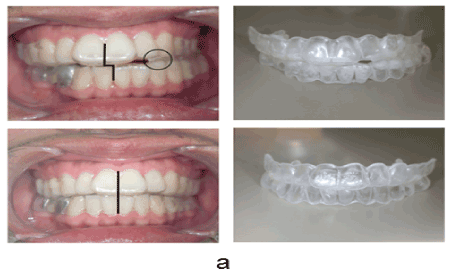 |
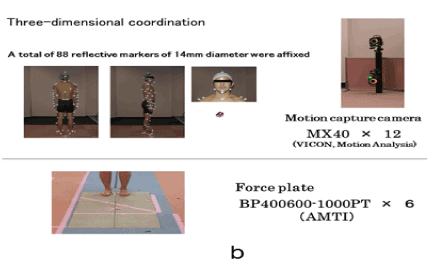 |
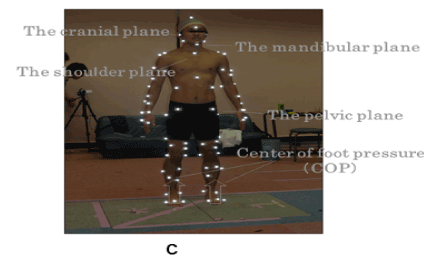 |
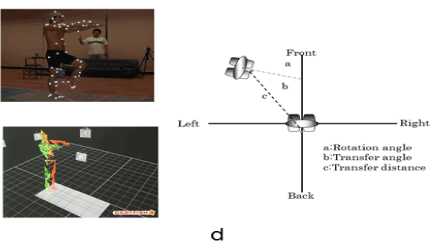 |
| Figure 1 | Figure 1b | Figure 1c | Figure 1d |
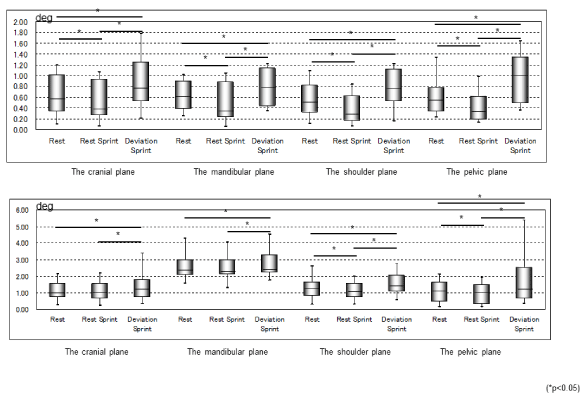 |
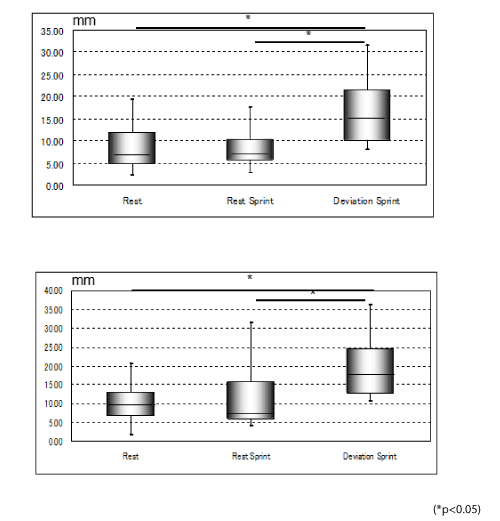 |
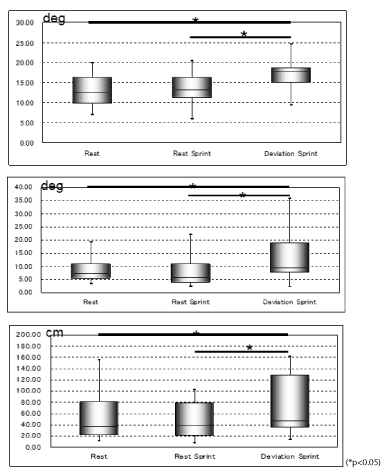 |
| Figure 2 | Figure 3 | Figure 4 |
Relevant Topics
- Electrical stimulation
- High Intensity Exercise
- Muscle Movements
- Musculoskeletal Physical Therapy
- Musculoskeletal Physiotherapy
- Neurophysiotherapy
- Neuroplasticity
- Neuropsychiatric drugs
- Physical Activity
- Physical Fitness
- Physical Medicine
- Physical Therapy
- Precision Rehabilitation
- Scapular Mobilization
- Sleep Disorders
- Sports and Physical Activity
- Sports Physical Therapy
Recommended Journals
Article Tools
Article Usage
- Total views: 14819
- [From(publication date):
February-2014 - Aug 17, 2025] - Breakdown by view type
- HTML page views : 10220
- PDF downloads : 4599
